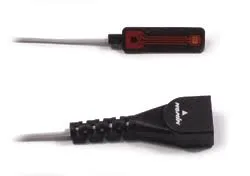A tabletop pulse oximeter is a medical device used to measure a person’s oxygen saturation (SpO2) and pulse rate. It’s commonly used in healthcare settings, such as hospitals and clinics, as well as in some home healthcare scenarios. Here are some key features and information about tabletop pulse oximeters:
- Principle of Operation: Pulse oximeters work by shining light through a translucent part of the body, typically a finger or earlobe, and measuring the amount of oxygen saturation in the blood. The device calculates SpO2 and pulse rate based on the absorption of red and infrared light by oxygenated and deoxygenated hemoglobin.
- Accuracy: Tabletop pulse oximeters are known for their accuracy and are commonly used in clinical settings to monitor patients’ oxygen levels. They provide real-time data that can be crucial for assessing a patient’s respiratory status.
- Display: tabletop pulse oximeters have a digital display that shows the oxygen saturation percentage and pulse rate in real time. The display is usually easy to read and may also include other information such as a waveform representing the pulse.
- Alarms: Many tabletop pulse oximeters come with customizable alarms that can be set to trigger when oxygen levels fall below a certain threshold. This is especially useful for continuous monitoring of patients.
- Data Logging: Some models have the ability to store and record data over time, which is beneficial for tracking a patient’s progress or for medical record-keeping.
- Portable vs. Stationary: While most pulse oximeters are portable and handheld for ease of use, tabletop models are typically stationary and designed to be placed on a flat surface, such as a bedside table or medical cart. This makes them suitable for continuous monitoring in a healthcare facility.
- Power Source: Tabletop pulse oximeters are typically powered by a direct electrical connection or rechargeable batteries. They are not usually battery-operated like handheld pulse oximeters.
- Use Cases: Tabletop pulse oximeters are commonly used in hospitals, clinics, and other healthcare facilities to monitor patients during surgery, in intensive care units, and in various medical procedures. They are also used for continuous monitoring of patients with respiratory conditions like chronic obstructive pulmonary disease (COPD).
- Maintenance: These devices require periodic calibration and maintenance to ensure accuracy. Healthcare professionals are responsible for maintaining and calibrating these devices as needed.
- Cost: Tabletop pulse oximeters are generally more expensive than portable, handheld models due to their advanced features and higher accuracy standards. They are an important investment for healthcare facilities to ensure patient safety.
It’s important to note that tabletop pulse oximeters are typically used in clinical and medical settings, and they may not be practical for personal use. For home use, smaller, handheld pulse oximeters are more common and cost-effective. Always consult with a healthcare professional for guidance on using a pulse oximeter and interpreting its readings.
Pulse Oximeter
Pulse Oximeter
Pulse Oximeter
Pulse Oximeter











